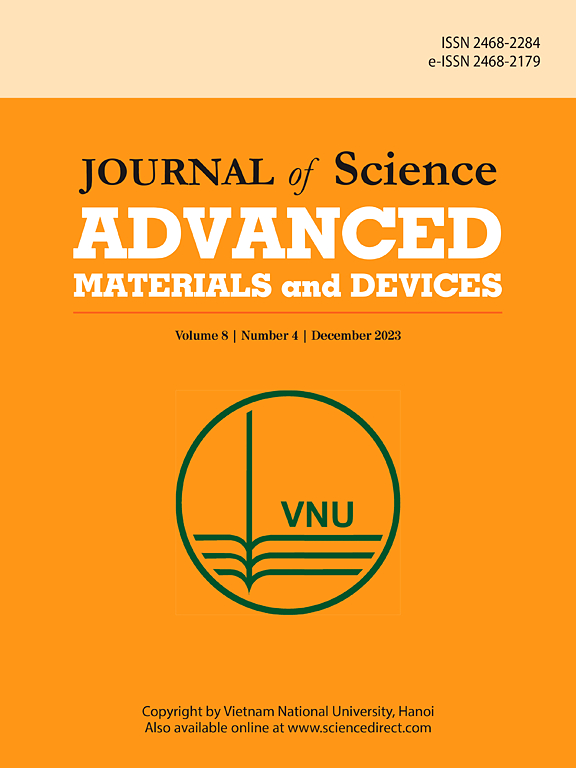Harnessing Z-scheme charge transfer in ultrathin C3N5/TiO2@Ti3C2Cl2 MXene nanosheets for sustainable water purification, hydrogen evolution, and biocompatibility
IF 6.7
3区 材料科学
Q1 MATERIALS SCIENCE, MULTIDISCIPLINARY
Journal of Science: Advanced Materials and Devices
Pub Date : 2025-01-03
DOI:10.1016/j.jsamd.2024.100846
引用次数: 0
Abstract
MXenes have recently emerged as one of the most promising conductive supports for photocatalytic water remediation and hydrogen evolution reaction (HER) electrocatalysts. This study presented the synthesis of a novel nanocomposite, TiO2@Ti3C2Cl2, using a one-step molten salt-shielded (MS3) method under an air atmosphere at a low temperature of 1000 °C. A unique aspect of this process was the successful extraction of copper from molten salt using iron bars without any chemical agents. The synthesized TiO2@Ti3C2Cl2 was subsequently coupled with low band-gap carbon nitride (C3N5) via an ultrasonic (US) technique, forming a Z-scheme ternary (C3N5/TiO2@Ti3C2Cl2) nanocomposites with a 2D/0D/2D structure. The ternary nanocomposite exhibited remarkable photocatalytic performance, achieving 100% efficiency in degrading dye molecules under optimal conditions, which included a pH of 5, a nanophotocatalyst dose of 100 ppm, a rhodamine B (Rh B) concentration of 10 ppm, room temperature, and a reaction time of 30 min. The C3N5/TiO2@Ti3C2Cl2/Cu composite also exhibited promising electrocatalytic performance for HER with a Tafel slope of 103 mV.dec−1 and an overpotential of 51 mV at a current density of 10 mA cm−2 under alkaline conditions. The significant improvement in photocatalytic water remediation and HER performance is likely due to several key factors: the strong interfacial coupling between the 2D/0D/2D materials, which promotes efficient charge separation; the reduced recombination rate of electron-hole pairs, enhancing photocatalytic efficiency; the highly improved electron-transfer processes, which accelerate reaction kinetics; and the increased number of exposed photo- and electrocatalytic active sites, providing more surface area for reactions. These combined effects result in better overall performance for photocatalytic and HER applications. Furthermore, the MTT assay demonstrated a reduction in the toxicity of C3N5 upon forming the ternary nanocomposite. These findings suggest that the synthesized ternary nanocomposite enhances photocatalytic and HER efficiency and reduces toxicity, making it a valuable material for environmental and energy applications.
求助全文
约1分钟内获得全文
求助全文
来源期刊

Journal of Science: Advanced Materials and Devices
Materials Science-Electronic, Optical and Magnetic Materials
CiteScore
11.90
自引率
2.50%
发文量
88
审稿时长
47 days
期刊介绍:
In 1985, the Journal of Science was founded as a platform for publishing national and international research papers across various disciplines, including natural sciences, technology, social sciences, and humanities. Over the years, the journal has experienced remarkable growth in terms of quality, size, and scope. Today, it encompasses a diverse range of publications dedicated to academic research.
Considering the rapid expansion of materials science, we are pleased to introduce the Journal of Science: Advanced Materials and Devices. This new addition to our journal series offers researchers an exciting opportunity to publish their work on all aspects of materials science and technology within the esteemed Journal of Science.
With this development, we aim to revolutionize the way research in materials science is expressed and organized, further strengthening our commitment to promoting outstanding research across various scientific and technological fields.
 求助内容:
求助内容: 应助结果提醒方式:
应助结果提醒方式:


